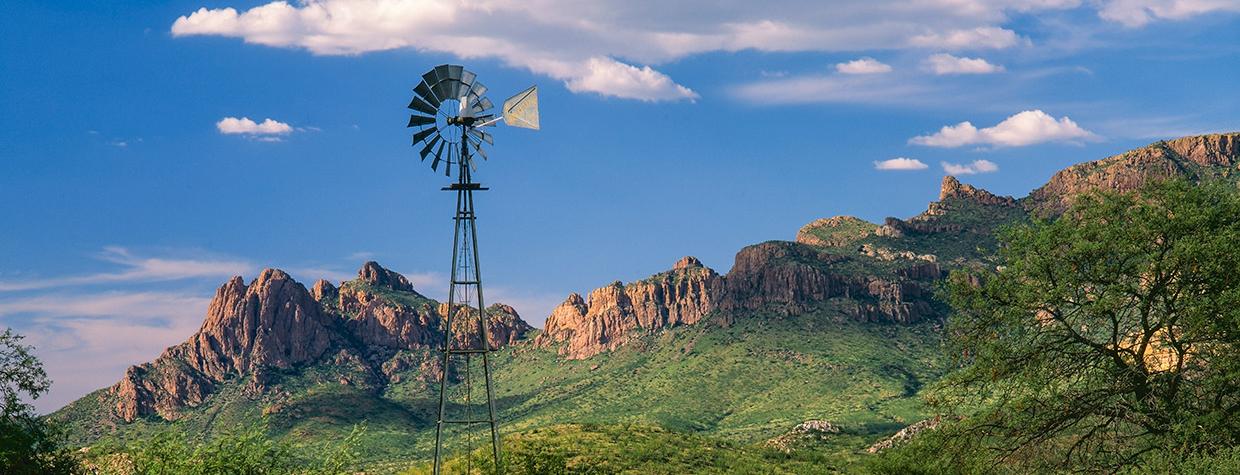The thing about Arivaca is that people seem to confuse it with Aravaipa. The similar-sounding nomenclature isn’t the only reason: Both places are in Arizona’s southern half, have roots in mining and are surrounded by spectacular scenery. But while Aravaipa is a remote, hard-to-reach ghost town, Arivaca is a quaint community accessed via a well-maintained, paved two-lane road — with plenty to see along the way.
From Interstate 19 in the Amado area, head west from the Arivaca Road exit. After a couple of quick turns, you’ll pass a few residences and enter a landscape where mesquite trees are the dominant plant species. It’s easy to see why mesquite, an infamous challenge for woodworkers, is the focus of a sawmill in nearby Tumacacori — there’s just so much of it around. To the south, you’ll also see the northern tip of the Tumacacori Mountains, which define part of the Santa Cruz River Valley’s western edge.
The mesquites get thicker as you traverse a low-lying area, and then, around Mile 5, you’ll get a view of the Cerro Colorado Mountains, a small range known for a mine of the same name. Thought to have been discovered by Spanish explorers in the 1700s, the Cerro Colorado Mine produced mainly silver ore from the 1850s to the 1930s. As Arivaca Road curves to the southwest, you’ll pass Cerro Colorado, a cone-shaped peak, on the right; the former mine site is just off the road a short distance past the peak.
From here, the roadside vegetation gets a bit more diverse, with cholla cactuses, yuccas and ocotillos appearing among the mesquites. And at a pullout at Mile 15.4, you’ll get an excellent view of a better-known mountain, Baboquivari Peak, to the northwest. Closer views of that mountain are coming later; for now, continue down the road, which offers more panoramas of nearby ranges, including the Las Guijas Mountains, as it twists and turns toward the tiny community of Arivaca.
Just outside town, don’t miss the Arivaca Cienega Trail, a short, easy route through a desert wetland along Arivaca Creek. It’s administered by nearby Buenos Aires National Wildlife Refuge and is known for attracting yellow-billed cuckoos, Lucy’s warblers and other bird species. A quarter-mile later, in Arivaca itself, you’ll find shops, an art gallery, a coffeehouse and cold drinks at La Gitana Cantina, which is housed in a former 1880s dance hall.
When you’re done exploring in town, continue through Arivaca to a “Y” intersection. Going left would take you to Arivaca Lake and the well-preserved ghost town of Ruby, but today, you’ll go right, onto Pusch Street (later Arivaca-Sasabe Road), which leads into the wildlife refuge and offers views of the San Luis Mountains to the south and Baboquivari Peak straight ahead. It also parallels a line of tall cottonwoods along Arivaca Creek, and you can get a closer look at that lovely riparian area via the Arivaca Creek Trailhead, at Mile 25.7.
The final stretch of the drive rolls gently downhill through mesquites and yuccas, with increasingly dramatic views of Baboquivari Peak along the way. The vaguely thumb-shaped mountain, which is sacred to the Tohono O’odham people, is protected by Arizona’s smallest wilderness area — just over 2,000 acres. Once you reach State Route 286, you can head south to the wildlife refuge’s visitors center or north to the Tucson area. And if your next stop is Aravaipa, you’ve got a long drive ahead of you.
tour guide
Note: Mileages are approximate.
Length: 35 miles one way (from Interstate 19)
Directions: From the Tucson area, go south on Interstate 19 for 34 miles to Arivaca Road (Exit 48). Turn right onto Arivaca Road and continue 0.1 miles to the I-19 frontage road. Turn right onto the frontage road and continue 0.1 miles to Arivaca Road. Turn left onto Arivaca Road and continue 23 miles to a “Y” intersection in Arivaca. Bear right, onto Pusch Street (which later becomes Arivaca-Sasabe Road), and continue 11.8 miles to State Route 286.
Vehicle requirements: None
Warning: Back-road travel can be hazardous, so be aware of weather and road conditions. Carry plenty of water. Don’t travel alone, and let someone know where you are going and when you plan to return.
Information: Visit Arivaca, visitarivaca.com; Buenos Aires National Wildlife Refuge, 520-823-4251 or fws.gov/refuge/buenos-aires

